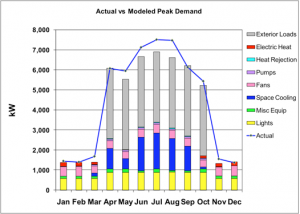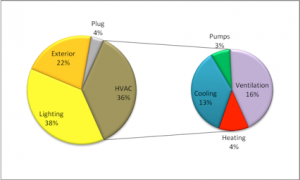Understanding ASHRAE Level 1, 2 & 3 Energy Audits
January 1, 2014

An energy audit is a systematic approach to problem solving and decision making. The primary goals of an energy audit are to qualify and quantify how the building energy systems are performing now, how that performance can be improved, and what will be the outcomes of those improvements in financial and non-financial terms.
Not all energy audits are the same, and it is helpful to understand the various levels of audits that are performed. Audits vary in detail, depending on the configuration of the building energy systems, the project parameters set by the client, and the scope and capabilities offered by the energy auditor. Because it usually is not possible to know where the audit process will lead and what level of effort will be most cost effective, ASHRAE (American Society of Heating, Refrigerating and Air-Conditioning Engineers) has defined three progressive levels, or types, of audits.
ASHRAE Level 1 – Walk-Through Analysis/Preliminary Audit
The Level 1 audit alternatively is called a “simple audit”, “screening audit” or “walk-through audit” and is the basic starting point for building energy optimization. It
involves brief interviews with site operating personnel, a review of the facility’s utility consumption and other operating data, and an abbreviated walk-through of the
building. The ASHRAE Level-1 audit is geared toward the rapid identification of the potential for energy improvements, understanding the general building
configuration, and defining the type and nature of energy systems. The audit should result in a preliminary, high-level, energy-use analysis for the entire facility, and a
short report detailing the findings, which may include identifying a variety of recognizable efficiency opportunities. Usually this report does not provide detailed recommendations, except for very visible projects or operational faults.
The ASHRAE Level-1 audit requires the lowest level of information about the building and its systems, and the least commitment of time by the building personnel. It is intended to help the energy team understand where the building performs relative to its peers; establish a baseline for measuring improvements; deciding whether further evaluation is warranted; and if so, where and how to focus that effort. The Level-1 also will outline the range of potential financial incentives available from Federal, State, Local, and Utility sources.
ASHRAE Level 2 – Energy Survey and Analysis
The next step for most facilities is the ASHRAE Level-2 audit/assessment. The Level-2 project starts with the findings of the Level-1 audit, and evaluates the building energy systems in detail to define a variety of potential energy-efficiency improvements. This should include the Building Envelope, Lighting, Heating, Ventilation, and Air Conditioning (HVAC), Domestic Hot Water(DHW), Plug Loads (things plugged into the wall), and Compressed Air and Process Uses (for manufacturing, service, or processing facilities).
The Level-2 assessment should include an evaluation of lighting, air quality, temperature, ventilation, humidity, and other conditions that may affect energy performance and occupant comfort. The process also includes detailed discussions with the building management team and occupants to explore potential problem areas, and clarify financial and non-financial goals of the program. Usually the auditor will use a computer model of the building, based on floor plans, mechanical schedules, and architectural drawings.
The Level-2 audit should result in a clear and concise report and briefing with the management team, describing a variety of Energy Efficiency Measures (EEMs) including no- and low-cost measures, modifications to system controls and building automation, operational changes, and potential capital upgrades. The findings should include costs and performance metrics, as well as a means for the Owner to evaluate the EEMs and decide how to proceed with implementation.
Many of the EEMs revealed during the ASHRAE Level-2 audit can be implemented quickly with rapid or immediate financial payback for the Owner. Other EEMs will require more detailed analysis of benefit and cost and the other goals that are important to the Owner. The audit should define next steps to accomplish this analysis and decision making. Sometimes it is through discussion with manufacturers or suppliers or other relatively simple means.
For other EEMs involving complex interaction among building systems and potentially large financial investments, it may be necessary to dig deeper into the building operation. This is where the ASHRAE Level-3 audit becomes useful.
ASHRAE Level 3 – Detailed Analysis of Capital Intensive Modifications
Some of the EEMs may require significant investments of capital, personnel, and other limited resources. Before making this level of investment, the owner might need a much more thorough and detailed understanding of the benefits, costs, and performance expectations. This is the purpose of the “investment-grade” Level-3 ASHRAE audit.
There may be only a few capital-intensive EEMs, or there may be dozens for larger facilities, and investment can range from tens of thousands to tens of millions of dollars. In most cases, since this cannot be clearly determined or accurately estimated in advance, the recommendation and scope definition for a Level-3 audit usually is an outcome of the Level-2 process.
Like some Level-2 assessments, the Level-3 uses a “whole-building computer simulation”, where a computer program is used to model the way the brick-and-mortar building would respond to changes in the energy systems. Depending on the EEMs, the ASHRAE Level-3 audit can involve much more detailed data collection over the course of weeks or months. Data loggers might be placed temporarily to monitor the operation of pumps and motors, temperatures of affected spaces, lighting levels, switching behavior, and other factors. The auditor may also consult with a construction expert to get accurate construction estimates to compare to the energy savings numbers.
The lines between these assessment levels might not be this sharp and clear. The accuracy of the analysis will be proportional to the accuracy of the information and the analysis – more detailed building information usually means better results. For instance, a Level-2 assessment can look a lot like a Level-3 assessment, except that the EEMs identified might be a little less accurately modeled than a Level-3 analysis. But the owner will have to decide whether it is worth the additional investment in time and money to gain another few percent of certainty about the potential outcomes. In other words, if the investment in the Level-2 assessment were increased by 50% in exchange for knowing with more certainty whether the investment in the EEM will pay back in 2.5 years or 2.8 years, is that a good investment of the additional time and money for a Level-3 compared to a Level-2 process? Maybe so, maybe not.
Microgrid recommends that a building owner invest in the Level-1 or Level-2 assessment first, and then decide what measures, if any, might require the more detailed analysis of a Level-3. That will help the auditor provide a faster assessment and a fair fee structure that doesn’t have a lot of contingency that might be needed to cover unknown EEM modeling.
ASHRAE Audit Summary Table
Level 1
- Rapid assessment of building energy systems
- Building energy benchmark
- High-level definition of energy system optimization opportunities Ø Outline applicable incentive programs
Level 2
- Detailed building survey of systems and operations Ø Breakdown of energy source and end use
- Identification of EEMs for each energy system
- Range of savings and costs for the EEMs
- Spotlight on Operational Discrepancies
- Outlining priorities for limited resources, next steps, and identification of EEMs requiring more thorough data collection and analysis
Level 3
- Whole-building computer simulation calibrated with field data
- Accurate modeling of EEMs and power/energy response
- Bid-level construction cost estimating
- (May involve longer term data collection and analysis)
- Investment-grade, decision-making support
Microgrid Energy provides Energy Star benchmarking, ASHRAE Level-1, -2, and -3 audits for buildings ranging from 3,000,000 square foot convention centers and professional sports stadiums to 10,000 square foot office buildings. Depending on the locale, there may be utility incentives that will fund part or all of the cost of the audit. There also may be local incentives that will help the owner pay for updates revealed through the audit. Lastly, there are tax incentives that could also apply to the efficiency improvements.







